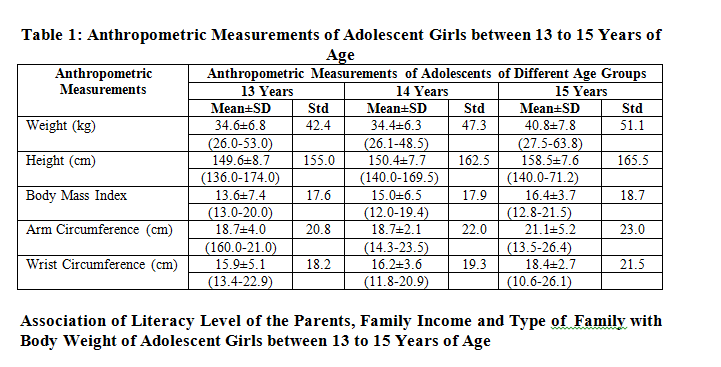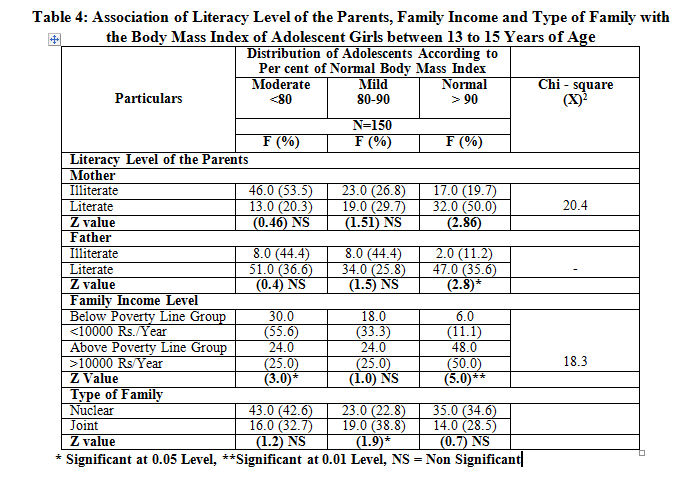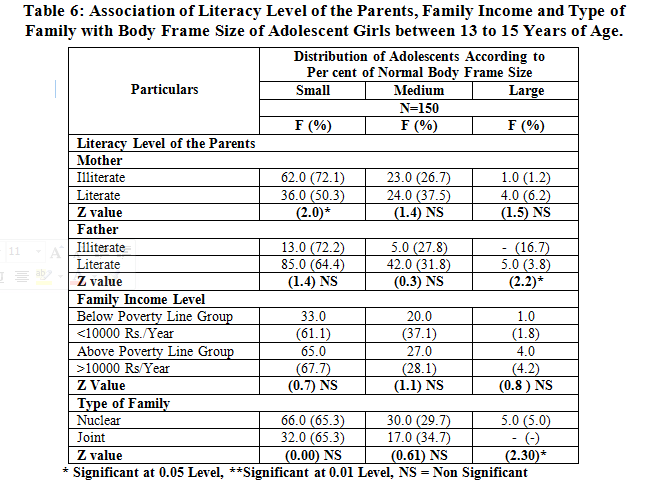Alleviation: An International Journal of Nutrition, Gender & Social Development, ISSN 2348-9340
Volume 2, Number 2 (2015) : 1-7
©Arya PG College, Panipat & Business Press India Publication, Delhi
www.aryapgcollege.com, www.apcjournals.com
Effect of Type of Family, its Status and Literacy Level on the Nutritional Status of Adolescent Girls
Abha Khetarpal
Associate Professor, Department of Home Science, DAV College, Yamunanagar
(Haryana), India
E-mail: abhakhetarpa@rediffmail.com
Introduction
Adolescence is regarded as the period of stress and strain, storm and strike. This is the time when an individual undergoes tremendous changes both physically, emotionally and psychologically. A profound and abrupt change is clearly perceptible into the development of the child who is neither too young nor too old. This sudden growth and development in the child is the unique characteristic of adolescence, an age which requires lots of care, affection, guidance, proper monitoring and motivation. It is because of the changes the child undergoes, stress and strain start ensuing. She/he starts behaving as a grown-up person but at times behaves childishly. There is frequent change in the behavioral act of the child at this stage. There is too much of eagerness as well as restlessness. The hormonal changes have an acute impact on the personality of the child. These changes result either in pride or shame, over-excitement or humiliation. Pimple and acne formation, genital development and increase in height and weight are the instinctive physical changes. Attraction towards opposite sex, being secretive in nature, group formation and active participation in mature discussion are some of the emotional changes, the child undergoes. However indulgence in untoward activities, aggressiveness, emotional imbalance and fickle-mindedness are some of the negative changes in the adolescents that need to be properly eyed. Such features differ from individual to individual in meagre or large. The period of greatest nutritional needs coincides with the peak rate of growth during adolescence (Between 10 and 13 years for girls and 11 and 14 years for boys). Anthropometric measurements are the simple measures often used in field studies by several groups of researchers for evaluating the physical growth (Jelliffe 1966). The changes in height and weight are especially remarkable during adolescence. Marked differences are observed in respect of onset as well as magnitude of the growth spurt among the adolescents of the same age and sex. Body growth is directly associated with poor socio-economic status of the family, size and type of the family and literacy level of their family.
The present investigation has been undertaken with following objectives:
1) To evaluate the nutritional status of adolescent girls between 13 to 15 years of age by anthropometric measurements and clinical examination.
2) To find out the association between nutritional status of adolescent girls with literacy level of the parents , their socio-economic status and type of family.
Material and Methods
One hundred and fifty adolescent girls between 13,14 and 15 years of age were selected randomly from the VIII, 1X and Xth standard of different Government schools of district Yamunanagar. Nutritional status of adolescents was evaluated by anthropometric measurements like bodyweight (kg), height (cm), arm circumference (cm), wrist circumference (cm) and triceps skin fold thickness (mm). All the anthropometric measurements were taken in triplicate for each adolescent and the averages were calculated. Clinical examination was also carried out to identify the deficiency disorders if any, among the adolescents. On the basis of anthropometric measurements, the Body mass index (BMI), Mid arm muscle circumference (MAMC) and Body frame size (BFS) were calculated by using the following formulae (Janner 1963).
a) BMI = Weight (kg)
Height (m)2
b) MAMC= Mid arm circumference (cm) - (3.14x triceps skin fold thickness) (cm)
c) BFS = Height (cm)
Wrist Circumference (cm)
The anthropometric measurements of the adolescents were expressed as percent of the standard for the specific age. On the basis of the per cent standard values, adolescents were grouped into different grades of nutrition , as normal (>90) , sub- normal (80 to 90) and below normal (<80). Association of literacy level of the parents, income level of the family and type of the family with the growth and development of adolescents was also determined.
Results and Discussion
Anthropometric Measurements of Adolescent Girls
The mean body measurements of adolescent girls between13, 14 and 15 years of age along with standard deviation and standard values are given in Table 1.
The values of body weight (kg), height (cm), arm circumference (cm) and wrist circumference (cm) of the adolescent boys were found to be markedly less than the standard values for the same age. Even body mass index (BMI) and mid arm muscle circumference (MAMC) values of the adolescents were far below the standards. It is evident from the result that the surveyed adolescents were shorter and lighter than well to do Indian girls. The result of body measurements also revealed that the rate of growth and physical development of adolescent girls in the present study was slower when compared to the normal healthy adolescent girls.

A relatively high per cent of body weight of adolescent girls was noticed with literate mothers (р < 0.01) while the per cent of adolescents with moderate degree of underweight was significantly higher with the illiterate mothers (Table 2). The percentage of adolescents with normal weight was high in families belonging to the higher economic group (р < 0.01) whereas the percentage of adolescents with moderate degree of underweight was relatively more in the families from low economic group. Chi-square test revealed significant association between body weight of adolescents with the literacy level and income of the family but there was no significant association between body weight and type of family.

Association of Literacy Level of the Parents, Family Income and Type of Family with the Height of Adolescent Girls between 13 to 15 Years of Age
According to the height of adolescent girls, they were grouped into normal, mild and moderate degrees of malnutrition. Eighty five adolescents in this study were found to be normal (Table 3). The number of adolescents affected with moderate degree of stunted growth was 30. Adolescent girls with normal height were significantly more in the families from high economic status. Similarly in nuclear families, adolescents had normal height as compared to their counterparts in joint families. The percentage of adolescents with normal height was markedly high in the families of literate parents Significant association of height of adolescents was found with literacy level of mothers, income level of the families and type of family (P <0.01).

Association of Literacy Level of the Parents, Family Income and Type of Family with the Body Mass Index of Adolescent Girls between 13 to 15 Years of Age
Only 19.7 per cent of adolescent girls of illiterate mothers and 50 per cent adolescents of literate mothers were observed to have normal BMI. On the other hand, 53.5 per cent and 20.3 per cent of adolescents of illiterate and literate mothers were found to have moderate deficiency of BMI respectively (Table 4). Similar trend was noticed with the educational status of fathers. BMI was normal in 11.1 per cent and it was below normal in 55.6 per cent of adolescents from families falling below poverty line. Among those from the above poverty line group, the BMI was normal in 44.8 per cent and below normal in 30.2 per cent. More number of adolescents of nuclear families (54.6%) had normal BMI than that of joint families (28.5%). Chi-square test revealed a significant association of BMI with the literacy level of mothers, income level of the families and type of family of adolescents (p < 0.01).


Association of Literacy Level of the Parents, Family Income and Type of Family with MAMC of Adolescent Girls between 13 to 15 Years of Age
The rationale behind mid arm muscle circumference (MAMC) is that muscle protein constitutes the greatest portion of body protein and a decrease in MAMC reflects the deficiency of protein.
Thus MAMC is an index of current protein status in the body. According to MAMC index, only 36 adolescent boys were found to be normal, while the remaining number of 114 showed mild to moderate degree of nutritional status depletion (Table 5).
MAMC of adolescents was significantly associated with the literacy level of the mother (p>0.01) whereas the association was found to be not significant between income level and type of family.
Association of Literacy Level of the Parents, Family Income and Type of Family with Body Frame Size of Adolescent Girls between 13 to 15 Years of Age.


disorder found in adolescents (30.7%) (Table 7). The signs of vitamins B-Complex deficiency included pin and needles numbness and angular stomatitis (10.7%). Vitamin 'A' deficiency was reflected as night blindness (2.6%). Anemia and muscular cramps due to mineral deficiency were present in 1.3 per cent and 4.0 per cent of adolescents respectively.
Conclusions
In conclusion, it can be said that more than two third of adolescent girls in the present study had poor physical growth and development. Literacy level of the mother, income level of the family and type of family were found to have significant association with the nutritional status of adolescent girls of the present study.
References
Janner JM (1963) Growth at Adolescent. Oxford and Edinburg: Blackwell Scientific Publication.
Jelliffe DB (1966) Assessment of the Nutritional Status of the Community. WHO: Geneva.

